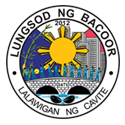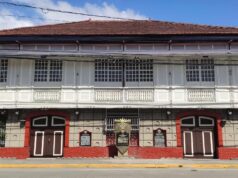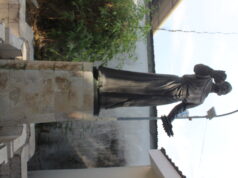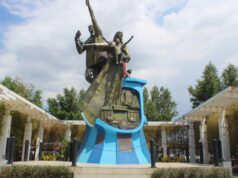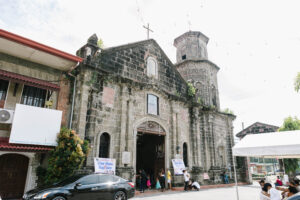

On 18 January 1752, Bacoor was granted a royal cedula by King Ferdinand VI of Spain to create its own parish, separate from the ecclesiastical jurisdiction of Cavite Puerto’s Inmaculada Concepcion curate (popularly known as San Pedro). This decree was issued to Governor General Francisco José de Ovando during the time of Bacoor Gobernadorcillo Francisco Adriano. One year before the release of the said decree, Bacoor’s first parish priest, Bachiller Don Jose Ximenez already made an inventory of ordered items for the improvement of the church structure. It also included the eventual 1756 recast of a church bell, dedicated by Don Lorenzo Cuenca to his venerated image of Nuestra Señora de los Remedios, and later co-dedicated to San Miguel Arcangel. In 1793, the second church bell was cast and dedicated by the Angeles family to San Jose Esposo de Nuestra Señora. Padre Mariano Gomes also commissioned a church bell in 1854 and was dedicated to San Caralampio, a champion of secularization. In 1877, two more bells were added by the Augustinian Recollect administration. One was dedicated to Nuestra Señora La Virgen Madre de Dios, and the second was for the Sagrado Corazon de Jesus.
The image of Bacoor’s patron saint, San Miguel Arcangel, is believed to have arrived in the shores of Cavite Puerto (Cavite City) on a galleon which it shared with the image of Nuestra Señora del Pilar of Imus. Though there was neither a known date as to the arrival of the image of the image of San Miguel Arcangel nor when it became the patron saint of Bacoor, historical accounts from the Official Archives of the Recollects in the Philippines places the arrival of the Nuestra Señora del Pilar image at the Enfermaria dela Casa Hacienda de Imus on May 28, 1694. All dates and available information considered, this may as well be the basis of the approximate arrival date of the image of San Miguel Arcangel in Bacoor, 58 years before the establishment of the parish church. Since its arrival, the Cuenca family served as camarero of both the image and carriage of San Miguel Arcangel.
In 1762, the British Invasion of Manila and Cavite saw the complete destruction of the original structure of the church because of its strategic location. It was cleft into two, from top to bottom, and was later burned.
The 1774 visit of Archbishop Basilio Sancho de Santas Justa y Rufina described the church as being made of stone, wood, and incomplete tile roofing, while the rectory was of wood, brick, and nipa. The donations for repairs were coursed through the church’s own Cofradia de la Nuestra Señora de los Remedios.
In 1791, Bachiller Don Domingo Sevilla Pilapil, then Bacoor’s parish priest and the first of two Vicario Foraneos from Bacoor’s curate, made sure that the rebuilding of the church with stone and mortar will be completed with the addition of a tiled roof, four-story belfry, baptistry, and patio. The structure that he led in rebuilding was completed, 28 years after the destruction of the original church structure.
In a similar manner, the term of Bachiller Don Mariano Gomes (1824-1872) was marked with constant repair and improvement of the church that began when the convento was completely constructed of stone in 1843. After more than 70 years, the church was once more rebuilt and enlarged from 1863-1870 with the help of the first Filipino architect Felix Rojas. It was also the time when the church was made to face Calle Real in the south to save it from seawater during high tide that started to enter the church interior when it was still facing Bacoor Bay. His term ended when the Spanish Governor General implicated him in the Cavite Mutiny of 1872. He was arrested at the convento of Bacoor and was later condemned to die by garrote on 17 February 1872, together with Fr. Jose Burgos and Fr. Jacinto Zamora. He would be the last indio Vicar Forane of Cavite until 1898 as the administration of Cavite churches were transferred to the Order of the Augustinian Recollects.
Other significant events that shaped the history of the Simbahan ng Bacoor:
May 31, 1898 – The third unfurling of the Philippine Flag by the revolutionaries after the victorious Battle of Bacoor Church. However, this unfurling at the church’s belfry made history as the first time the red portion of the flag was on top, signifying the country is in the state of war.
June 13, 1899 – The altar, its dome ceiling, and retablos, were all destroyed during the American bombing of Bacoor to prevent reinforcements from helping their comrades engaged in battle at the Zapote river. The church and town vicinity were bombed with 10-inch shells. Afterwards, they converted the church as their dormitory, the convento as a hospital, and the belfry as their guard tower.
December 4, 1902 – The celebration of masses and religious sacraments were transferred from the church to the house of Don Juan Cuenca. The transfer occurred after then cura parroco, Padre Fortunato Clemeña left the catholic faith and joined the Iglesia Filipina Independiente (IFI) where he became its first Obispo de Cavite. Bacoor’s Presidente Municipal Felix Cuenca, after receiving orders of church administration transfer from William Howard Taft via Cavite Governor Mariano Trias, was already facilitating the voluntary turnover of the church keys between IFI’s Cavite Bishop Clemeña and Iglesia Catolica Apostolica Romana’s Cavite Vicar Forane Policarpo Villafranca when another letter arrived from Manila instructing him to maintain the status quo in Bacoor.
November 24, 1906 – After four years of hearing the primary case regarding the ownership of the church in Lagonoy, Camarines Sur between the Roman Catholic Church represented by Father Jorge Barlin, and Philippine Independent Church represented by Bishop Vincente Ramirez, the Supreme Court ruled in favor of the Roman Catholic Church. This became the basis of all succeeding church ownership cases including the Bacoor church administration. The church structure was then returned to the catholic clergy.
December 28, 2020 – The Parish of St. Michael, the Archangel was declared by the National Museum of the Philippines as an Important Cultural Property.
August 2, 2021 – Leading to the GOMBURZA 150 commemoration, an improved personage marker for Padre Mariano Gomes was unveiled by the National Historical Commission of the Philippines. Moreover, the Landas family descendants of Padre Mariano Gomes’ only brother, Jose Gomes, complemented the marker with a bust statue and the restoration of Padre Gomes’ 1854 San Caralampio Bell.
January 18, 2022 – As the Parish of St. Michael, the Archangel commemorated its 270th Anniversary, the 13th generation of the Cuenca family presented the repaired and restored 1756 Nuestra Señora de los Remedios Bell that was commissioned in the 18th century by their ancestor, Don Lorenzo Cuenca.
March 2, 2022 – The Parish of St. Michael, the Archangel unveiled two important markers. First is the Important Cultural Property Marker from the National Museum of the Philippines, and second, the National Historical Commission of the Philippines’ Level II historical marker under the category of buildings/structures, house of worship type. The two markers, along with the personage marker of Padre Mariano Gomes, were approved by their respective cultural agencies after intensive research, and nomination that emanated from the Office of Deputy Speaker Strike B. Revilla.
How to get there: https://maps.app.goo.gl/hpdRHpe2hqUATF1c6
